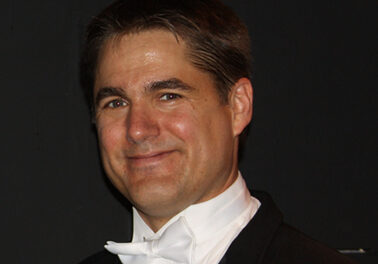Downtown Asheville on a Sunday afternoon during the Christmas season is a merry scene with people and cars everywhere and virtually no place to park. The Asheville Symphony Orchestra’s holiday program in Thomas Wolfe Auditorium, with the Asheville Symphony Chorus and guest soloists Jennifer Davison, soprano, Deborah Domanski, mezzo soprano, and Scott Joiner, tenor was delayed, I’m assuming, to accommodate those hiking to the venue from the nether regions, and still people streamed in 20 minutes after the start of the performance. The draw, of course, was a holiday program of choral favorites, anchored by the iconic composition du jour, Handel’s Messiah (Part I with the “Hallelujah” chorus ending Part II). The conductor was Maestro Daniel Meyer with Michael Lancaster, Director of the Asheville Symphony Chorus, conducting the sole a cappella work. Heightening the festive atmosphere was a beautifully decorated stage and the raffle drawing at intermission for a gleaming red Porsche Boxter supplied by Harmony Motors, the concert’s sponsor.
The soloists are all singers with extensive experience in opera and who brought their dramatic interpretive skills to this oratorio performance. Though standing in lieu of acting, each sang with facial expressions reflective of their respective texts and summoned their best technical chops to navigate Handel’s challenging score. Ms. Domanski has appeared on a previous Asheville Symphony Orchestra concert of Messiah. Ms. Davison and Mr. Joiner are known to Asheville opera goers, having appeared in leading roles with the Asheville Lyric Opera to critical acclaim.
One hears Messiah frequently, and who can blame directors for choosing to perform it, as it deserves pride of place as a work with nearly universal appeal. From the opening of the French-styled Overture, Meyer led the orchestra (reduced to “Baroque” dimensions) in a performance that was noteworthy for its incisive articulations and rhythms, and very brisk tempos. Each soloist was amplified, correcting what could have been a singer-orchestra imbalance. The harpsichord, situated midway between the conductor and the chorus at the back of the stage, was amplified too, though not nearly enough to lend much percussive weight to the ensemble. And while the soloists and orchestra were able to perform at Meyer’s tempos, the chorus clearly was not, especially in those movements notorious for their extended melismatic passages in sixteenth notes (“For unto us a child is born,” “And he shall purify”). That said, it was obvious the chorus had been well prepared in rehearsal, as there were many moments when they sang as if with one voice, clearly enunciating the text in well-defined phrases and singing in light tones when necessary. The resulting performance was edgy and generally a bit unnerving.
After intermission came a series of traditional carols in sumptuous arrangements played with an expanded orchestra and electronic keyboard. Wilberg’s arrangement of “Fum, Fum, Fum” brought the house down with its sassy piccolo obbligato and clever exchanges between chorus and orchestra, and his version of “O Come, All Ye Faithful” which blossomed into full orchestral regalia complete with (synthesized) organ was an audience favorite. Yonn’s “Gesu Bambino” arranged by Ryden brought back Ms. Domanski and Ms. Davison for a lovely duet. The sole vocal work in its original form was Morten Lauridsen’s poignant “O Nata Lux,” conducted by Lancaster and dedicated to the memory of those tragically lost in the recent Connecticut school shooting. There were four Rutter arrangements: “Joy to the World, “O Holy Night” (featuring Joiner’s thrilling, soaring tenor voice), “Silent Night,” and “We Wish You a Merry Christmas,” a reaffirmation of Rutter’s popularity with American audiences.











